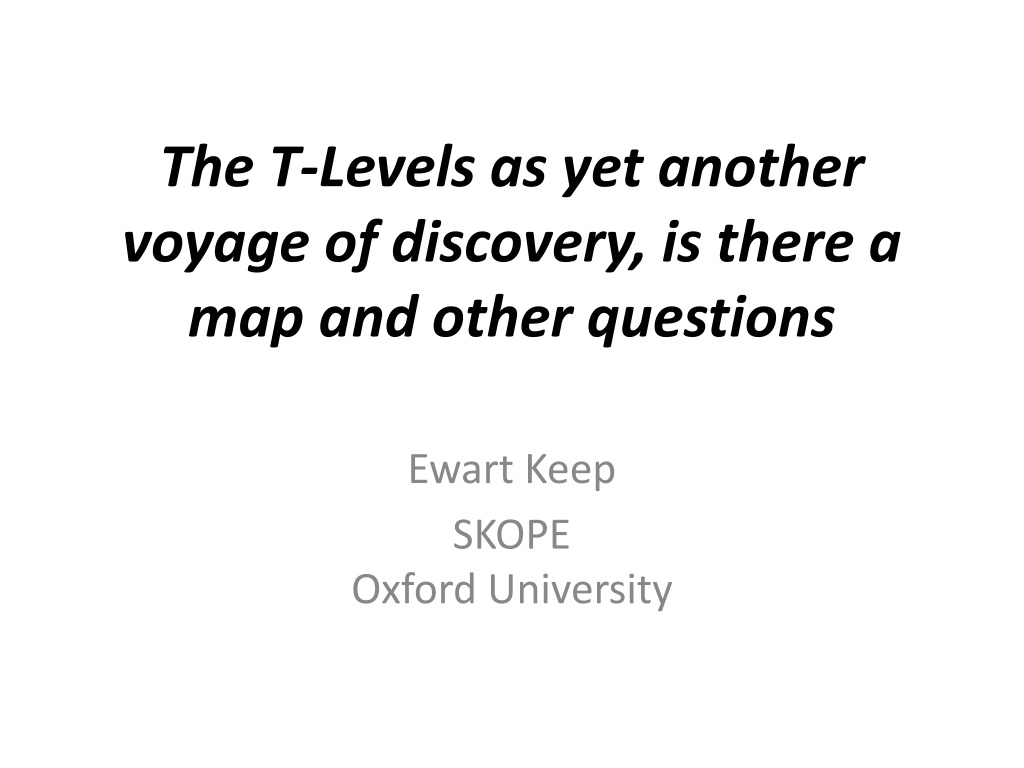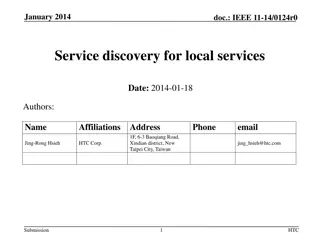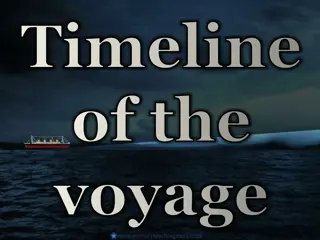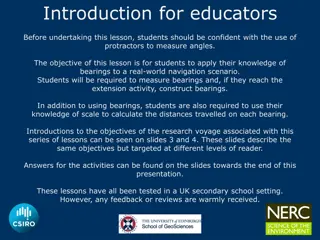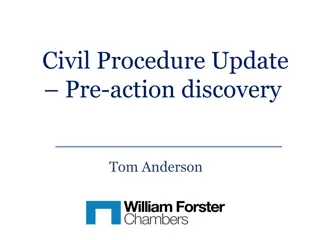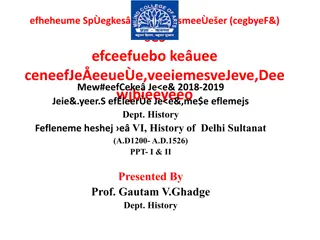T-Levels: A Voyage of Discovery
This presentation poses critical questions about past attempts at VQ reform, the need for either qualification or curriculum reform, policy development gaps, the magnitude of change with T-Levels, and concerns about the tight timetable in the government's planning process. It aims to provoke thoughtful discussions on the challenges ahead in skills planning.
Download Presentation

Please find below an Image/Link to download the presentation.
The content on the website is provided AS IS for your information and personal use only. It may not be sold, licensed, or shared on other websites without obtaining consent from the author.If you encounter any issues during the download, it is possible that the publisher has removed the file from their server.
You are allowed to download the files provided on this website for personal or commercial use, subject to the condition that they are used lawfully. All files are the property of their respective owners.
The content on the website is provided AS IS for your information and personal use only. It may not be sold, licensed, or shared on other websites without obtaining consent from the author.
E N D
Presentation Transcript
The T-Levels as yet another voyage of discovery, is there a map and other questions Ewart Keep SKOPE Oxford University
A set of questions. This presentation simply seeks to pose a set of questions some actual, a few rhetorical To some, the presenter will offer his possible answer For others, he has no idea what the answer might be The aim of this process is to identify issues and problems that will confront the Skills Plan
Were previous attempts at VQ reform too unambitious? Both the Sainsbury Review and the Skills Plan claim that past attempts at qualification reform failed because they were too unambitious and not systemic enough. Is this true? NVQs, competence-based models and NCVQ Tomlinson and the Diploma
Qualification reform (again) or curriculum reform? Charlotte Bosworth, Director of Skills and Employment at OCR: If we are to have an education system that can respond to a changing world, then we cannot have an education system that has to respond to qualification related reform every five years....we must also look at teaching capacity, resources, funding, training, etc....To truly effect change, we cannot just change the content of the test that learners sit at the end of the course . FE Week: April 2015
Is policy development missing some of the issues? 1. Standards design (DfE/IfATE/route panels) 2. Qualification design (awarding bodies) 3. Assessment methods (awarding bodies/Ofqual) 4. Curriculum (strangely invisible as an issue) 5. Pedagogy 6. Resources and staffing CAVTL, funding, placements .
Is this a big change or a little change (or even not much change at all)? Depending on who you talk to T-levels are either a revolutionary development that mark a complete break with the past OR An incremental adjustment that will see many existing VQs re-packaged/tweeked and then inserted into the pathways.
Is the timetable too tight? The government s latest timeline allows just under a year from selecting an awarding organisation to finalising the content, then implies teaching will commence four months later .Current government thinking doesn t show any appreciation of real timescales and it s worrying that they seem not to have learned from past mistakes . Kirstie Donnelly, managing director, City & Guilds, FE Week, 13 March 2017: 16
Do policy makers understand other countries Mode B tertiary systems? Probably not! As OECD (Beyond School) and Alison Wolf (Remaking tertiary education) note, in most countries there is a vibrant sub-degree (Ls4&5) vocational route, often delivered by specialised institutions. This provision is post- upper secondary (i.e. post-19).
But here.. HEIs have ignored sub-degree (see Wolf) and most FE is at Levels 2&3, not 4&5. Policy development on the T-levels seems to be focused on L2 & 3, and with the expectation that everything will be complete by age 19 because after that it s loan funding only. Will a new sub-degree tier be needed, and how will this be funded, and who will provide it?
Underlying this is the fact that: A significant proportion of our upper secondary phase is actually spent remediating prior failure at lower secondary (or lower) levels. Will the Transition Year solve this? Remember, it all has to be done and dusted before age 19.
Pathways in education V. pathways in the labour market Pathways in E&T (progression still very much seen as vertical and focus is on initial learning) Pathways in labour market could be vertical and/or horizontal latter career development The problem of short ladders and dead ends see Gary Morris s SKOPE issues paper.
Research suggests. 1. UKCES s progression pathways work 2. Major NCVER project on vocational families and pathways in Australia Both indicate that occupational/sectoral labour market traditions and structures help determine what is possible by way of creating viable pathways. Policy seems obsessed by pathways inside education, with limited concern about the labour market side of the equation.
Mandatory work placements How can these be mandatory, when the ability to supply them is entirely dependent upon the voluntary participation of employers and their willingness to provide places?
Incorporating apprenticeship standards into the 15 routes how? Many apprenticeship standards are very job specific and narrow (mineral weighbridge operator L2) Many contain no qualification which is a major stumbling block assessment against standard is all there is.
Awarding bodies will they play ball? The policy assumption is that ABs will be straining at the leash to bid for the monopoly licence to deliver each of the routes. Is this going to be the case? Is OCR s withdrawal from apprenticeship standard end-point assessment a straw in the wind?
Employers the $64,000 question Many employers have been involved in earlier qualifications reform efforts (Diplomas, revision of NOS) and may not be all that happy with the abandonment of the fruits of their labour. How many will pile into developing the routes?
Employer input into route design = Design input requires employers to be able to: 1. Specify the level and type of skill demand/need they have 2. To plan ahead 3. They also need to be interested and willing to devote time and resources.
And.. Foreword to Sainsbury Review: Young people will only work hard to get a qualification, and value it highly when they get it, if employers when recruiting give priority to individuals who possess it But what we know about R&S suggests that this may not be the case. Works better in a world where LtP is more extensive.
The Transition year The clear organising framework will cover all occupations where there is a substantial requirement for technical knowledge and practical skills. Technical education is not a catch all term for everything that isn t GCSE, A-levels and degrees. So, falling outside of technical education are many skilled occupations, such as retail assistant, which do not require a significant amount of technical knowledge .to perform well in these occupations does not require a substantial technical training. Instead, short, job specific training while in employment is more appropriate Lord Sainsbury, FE Week, 14 November 2016: 12
Choices at age 16 1. 2. 3. Academic A levels General Vocational BTEC (1:3 HE entry) Technical education pathway at L2 or L3 OR a Transition Year followed by: Move onto L3 Tech pathway Traineeship Apprenticeship L2 Informal, on-the-job training Job with no training NEET In many colleges, there will be more students on transition/traineeship/L2 apprenticeship than on TEPs
Conversion courses The Sainsbury Review promised that there would be some form (vaguely specified) of conversion provision that would allow someone on A levels to convert to a L3 T-level/route and vice versa. This seems to have dropped off the agenda, at least to date. Is it feasible to design and deliver this (again, the by age 19 issue looms)?
Impacts on schools Many school VI forms dabble in vocational provision. Will some want to try and offer at least some of the 15 routes? If so, which routes look more viable in a school environment?
Impacts on adult VET It is monumentally unclear what impacts policy makers expect the pathways/T-levels to have on adult VET provision. Are the pathways only for young people, or will adults be able/expected to join them? Will the existing set of 17,000+ vocational qualifications still be on offer to the post-19s who are not on apprenticeships? How can/will T-levels be on offer to adults wanting to upskill and/or re-skill?
Quality and control, funding and governance who leads? 1. IfATE 2. Ofsted 3. Ofqual 4. DfE Who leads on what? Who decides?
Employer led? All VET reforms are billed as employer-led, but we know from experience that for policy makers employer-led often means employers doing what is expected/demanded of them by government. The IfATE is in the lead on developing the routes. It is supposed to be an independent, arms length, employer-led body. 6 out of 8 of its senior management team are seconded civil servants. The UKCES was supposed to be independent and employer- led, but it was too independent for BIS s liking and got axed. How long will the IfATE last?
